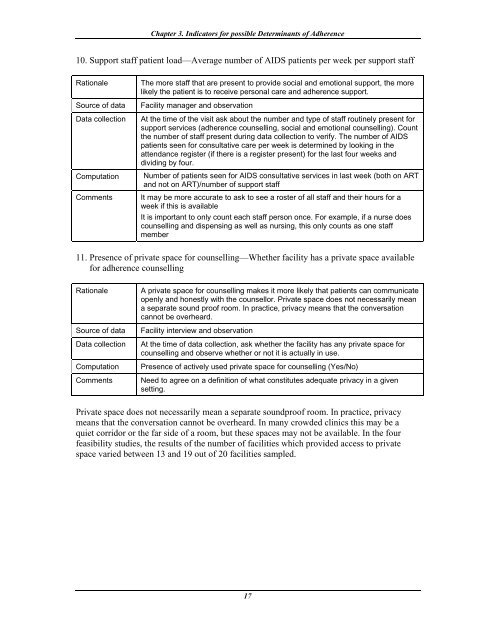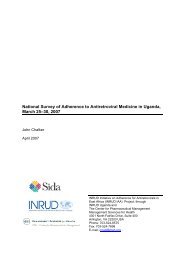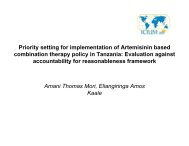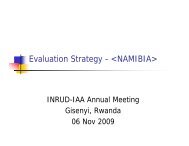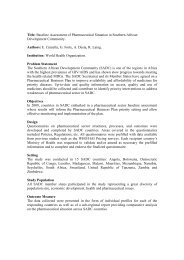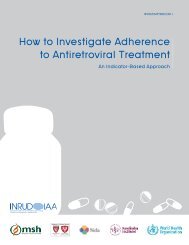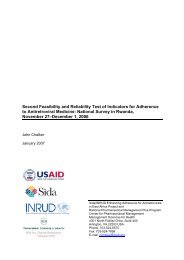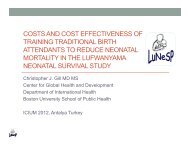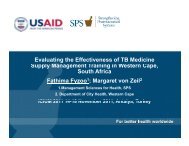How to investigate Adherence to Antiretroviral Treatment ... - INRUD
How to investigate Adherence to Antiretroviral Treatment ... - INRUD
How to investigate Adherence to Antiretroviral Treatment ... - INRUD
Create successful ePaper yourself
Turn your PDF publications into a flip-book with our unique Google optimized e-Paper software.
Chapter 3. Indica<strong>to</strong>rs for possible Determinants of <strong>Adherence</strong><br />
10. Support staff patient load—Average number of AIDS patients per week per support staff<br />
Rationale<br />
Source of data<br />
Data collection<br />
Computation<br />
Comments<br />
The more staff that are present <strong>to</strong> provide social and emotional support, the more<br />
likely the patient is <strong>to</strong> receive personal care and adherence support.<br />
Facility manager and observation<br />
At the time of the visit ask about the number and type of staff routinely present for<br />
support services (adherence counselling, social and emotional counselling). Count<br />
the number of staff present during data collection <strong>to</strong> verify. The number of AIDS<br />
patients seen for consultative care per week is determined by looking in the<br />
attendance register (if there is a register present) for the last four weeks and<br />
dividing by four.<br />
Number of patients seen for AIDS consultative services in last week (both on ART<br />
and not on ART)/number of support staff<br />
It may be more accurate <strong>to</strong> ask <strong>to</strong> see a roster of all staff and their hours for a<br />
week if this is available<br />
It is important <strong>to</strong> only count each staff person once. For example, if a nurse does<br />
counselling and dispensing as well as nursing, this only counts as one staff<br />
member<br />
11. Presence of private space for counselling—Whether facility has a private space available<br />
for adherence counselling<br />
Rationale<br />
Source of data<br />
Data collection<br />
Computation<br />
Comments<br />
A private space for counselling makes it more likely that patients can communicate<br />
openly and honestly with the counsellor. Private space does not necessarily mean<br />
a separate sound proof room. In practice, privacy means that the conversation<br />
cannot be overheard.<br />
Facility interview and observation<br />
At the time of data collection, ask whether the facility has any private space for<br />
counselling and observe whether or not it is actually in use.<br />
Presence of actively used private space for counselling (Yes/No)<br />
Need <strong>to</strong> agree on a definition of what constitutes adequate privacy in a given<br />
setting.<br />
Private space does not necessarily mean a separate soundproof room. In practice, privacy<br />
means that the conversation cannot be overheard. In many crowded clinics this may be a<br />
quiet corridor or the far side of a room, but these spaces may not be available. In the four<br />
feasibility studies, the results of the number of facilities which provided access <strong>to</strong> private<br />
space varied between 13 and 19 out of 20 facilities sampled.<br />
17


